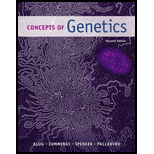
Concept explainers
(a)
To determine:
The experimental evidence that confirms scientist has introduced a useful gene into a transgenic organism and it performs as they anticipate.
Introduction:
The genetic engineering is the technique of artificial manipulation of the genes which includes the transfer of DNA from donor to recipient and artificial synthesizing of DNA. It is also called recombinant DNA technology. The scientist Paul Berg in 1972 produced the first recombinant DNA by joining the monkey SV40 virus DNA with lambda virus DNA. This genetic engineering possesses several applications in the commercial field.
(b)
To determine:
The method of using the DNA analysis to determine that a human fetus has sickle-cell anemia
Introduction:
The genetic testing is the testing of genes that identifies any changes in the information contained in the DNA. It is mainly used for diagnosing the mutation occurs within the genome. It is the prognostic measure for a disease to enhance the better treatments for the patients. Genetic testing is divided into many types namely prenatal genetic testing, preimplantation genetic testing, carrier testing, newborn screening, etc.
(c)
To determine:
The method of using the DNA microarray analysis to identify specific genes that are being expressed in a specific tissue.
Introduction:
The microarray is the molecular technique which is used to detect the gene expression pattern of many genes at the same time. The types of microarrays are DNA microarray, protein microarray, tissue microarray, peptide microarray, antibody microarray, cellular microarray, etc. This biochip consists of microscopic slides usually made up of nylon, silicon, and glass. It is also used in transcription factor binding analysis and genotyping
(d)
To determine:
That how GWAS are carried out and the information provided by it.
Introduction:
To identify the genes that influence the disease risk, microarray-based genomic analysis has led geneticists to employ powerful new strategies called genome-wide association studies (GWAS). It has been the great expansion in the GWAS that reported in the past 8 years. It has been reported that GWAS have resulted in 1000 scientific publications that join 3000
(e)
To determine:
The technical reasons why gene therapy is difficult to carry out effectively.
Introduction:
The gene therapy is the effective treatment for cancer. It is the technique of replacement of functional gene in place of the defective gene. And thus the functional gene gets transcribed and results in the formation of normal
Want to see the full answer?
Check out a sample textbook solution
Chapter 22 Solutions
Concepts of Genetics (11th Edition)
- Explain in a small summary how: What genetic information can be obtained from a Punnet square? What genetic information cannot be determined from a Punnet square? Why might a Punnet Square be beneficial to understanding genetics/inheritance?arrow_forwardIn a small summary write down:arrow_forwardNot part of a graded assignment, from a past midtermarrow_forward
- Noggin mutation: The mouse, one of the phenotypic consequences of Noggin mutationis mispatterning of the spinal cord, in the posterior region of the mouse embryo, suchthat in the hindlimb region the more ventral fates are lost, and the dorsal Pax3 domain isexpanded. (this experiment is not in the lectures).a. Hypothesis for why: What would be your hypothesis for why the ventral fatesare lost and dorsal fates expanded? Include in your answer the words notochord,BMP, SHH and either (or both of) surface ectoderm or lateral plate mesodermarrow_forwardNot part of a graded assignment, from a past midtermarrow_forwardNot part of a graded assignment, from a past midtermarrow_forward
 Human Anatomy & Physiology (11th Edition)BiologyISBN:9780134580999Author:Elaine N. Marieb, Katja N. HoehnPublisher:PEARSON
Human Anatomy & Physiology (11th Edition)BiologyISBN:9780134580999Author:Elaine N. Marieb, Katja N. HoehnPublisher:PEARSON Biology 2eBiologyISBN:9781947172517Author:Matthew Douglas, Jung Choi, Mary Ann ClarkPublisher:OpenStax
Biology 2eBiologyISBN:9781947172517Author:Matthew Douglas, Jung Choi, Mary Ann ClarkPublisher:OpenStax Anatomy & PhysiologyBiologyISBN:9781259398629Author:McKinley, Michael P., O'loughlin, Valerie Dean, Bidle, Theresa StouterPublisher:Mcgraw Hill Education,
Anatomy & PhysiologyBiologyISBN:9781259398629Author:McKinley, Michael P., O'loughlin, Valerie Dean, Bidle, Theresa StouterPublisher:Mcgraw Hill Education, Molecular Biology of the Cell (Sixth Edition)BiologyISBN:9780815344322Author:Bruce Alberts, Alexander D. Johnson, Julian Lewis, David Morgan, Martin Raff, Keith Roberts, Peter WalterPublisher:W. W. Norton & Company
Molecular Biology of the Cell (Sixth Edition)BiologyISBN:9780815344322Author:Bruce Alberts, Alexander D. Johnson, Julian Lewis, David Morgan, Martin Raff, Keith Roberts, Peter WalterPublisher:W. W. Norton & Company Laboratory Manual For Human Anatomy & PhysiologyBiologyISBN:9781260159363Author:Martin, Terry R., Prentice-craver, CynthiaPublisher:McGraw-Hill Publishing Co.
Laboratory Manual For Human Anatomy & PhysiologyBiologyISBN:9781260159363Author:Martin, Terry R., Prentice-craver, CynthiaPublisher:McGraw-Hill Publishing Co. Inquiry Into Life (16th Edition)BiologyISBN:9781260231700Author:Sylvia S. Mader, Michael WindelspechtPublisher:McGraw Hill Education
Inquiry Into Life (16th Edition)BiologyISBN:9781260231700Author:Sylvia S. Mader, Michael WindelspechtPublisher:McGraw Hill Education





